

David MacKay Sustainable Energy without the hot air. Sustainable Energy – without the hot air David MacKay, professor of Physics at Cambridge, has recently published a wide ranging book on Sustainable Energy.

He brings this huge subject down to size by measuring our use and sources of energy in understandable units on a human scale: kWh per day per person. He examines our uses of energy, and sources of energy and concludes that 90% of current energy used in the UK derives from fossil fuels and that this is clearly unsustainable. He examines what sources of renewable energy are available and what quantity we could reasonably achieve from solar energy, wind power, wave power etc. and comes to some interesting conclusions about the scale of the problem and the practicalities involved.
This excellent book is freely available on line: You can download a synopsis, individual chapters, or the whole book. Institute for Sustainable Design (Welsh) 2010_26.content.09648.pdf. Www.greenbooklive.com/filelibrary/responsible_sourcing/BES_6001_Issue2_Final.pdf. CL-04-10 Cynllunio ar gyfer Adeiladau Cynaliadwy - Diweddariad i’r Cod Cartrefi Cynaliadwy (Polisi Cynllunio Cymru, Adran 4.11) Improving the energy efficiency of buildings and using planning to protect the environment - Policy. Issue In 2009 buildings accounted for about 43% of all the UK’s carbon emissions.
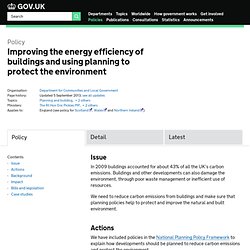
Buildings and other developments can also damage the environment, through poor waste management or inefficient use of resources. The Alliance for Sustainable Building Products - ASBP. Www.unep.org/sbci/pdfs/sbci-bccsummary. RESTATS Home. Sustainable Innovation Research. The Centre for Sustainable Design (CfSD) offers consultancy services based on its core competence and has undertaken projects for both private and public sector clients.

Considerable expertise has been built in eco-design in the electronics sector, especially in South-East Asia. CfSD has completed research in areas related to sustainable consumption and production (SCP), ‘producer responsibility’, product policy, eco-innovation, eco-design, design for remanufacturing, eco(packaging) design, marketing, procurement, supply chain management, product-servicesystems (PSS) and new business models. Carbon Trust [ Project No. 2006-051-233 ] Sustainable Innovation. Joint UK-Sweden Initiative on Sustainable Construction. DuPont™ Energain® Lime Technology - lime-based building products. Tradical® Hemcrete® is a bio-composite building material made from hemp shiv (the woody core of Industrial Hemp) and a lime based binder called Tradical® HB.
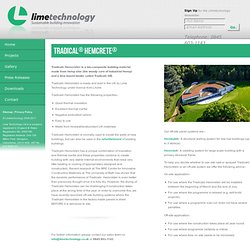
Tradical® Hemcrete® is made and sold in the UK by Lime Technology under licence from Lhoist. Tradical® Hemcrete® has the following properties:- Good thermal insulation Excellent thermal inertia Negative embodied carbon Easy to use Made from renewable/abundant UK materials Tradical® Hemcrete® is normally used to create the walls of new buildings, but can also be used in the refurbishment of existing buildings. Ecological Building Systems. Sustainable Construction. The Strategy for Sustainable Construction is a joint industry and Government initiative intended to promote leadership and behavioural change, as well as delivering benefits to both the construction industry and the wider economy.
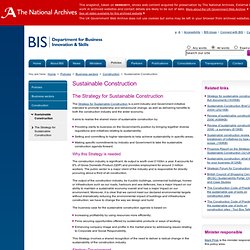
It aims to realise the shared vision of sustainable construction by: Providing clarity to business on the Government's position by bringing together diverse regulations and initiatives relating to sustainability; Setting and committing to higher standards to help achieve sustainability in specific areas; Making specific commitments by industry and Government to take the sustainable construction agenda forward.
Why this Strategy is needed The construction industry is significant: its output is worth over £100bn a year. It accounts for 8% of Gross Domestic Product (GDP) and provides employment for around 3 million workers. The business case for the sustainable construction agenda is based on: Strategy Development The final strategy was released on 11th June 2008. Welcome to Vertical Garden Patrick Blanc. Natural Building Technologies. Www.greenspec.co.uk. Plants / Seeds « The UK Green Roofs Directory - for commercial and domestic green roof systems.
Phase Change Material Home Page. Phase Change Material Research A Warm Welcome to my web site.
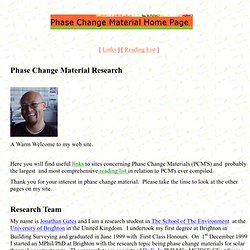
Here you will find useful links to sites concerning Phase Change Materials (PCM'S) and probably the largest and most comprehensive reading list in relation to PCM's ever compiled. Thank you for your interest in phase change material. Please take the time to look at the other pages on my site. Research Team My name is Jonathan Gates and I am a research student in The School of The Environment at the University of Brighton in the United Kingdom. Background At the 1992 conference on climate change, the United Nations Inter-governmental panel concluded that a 60% reduction in the use of fossil fuel would have to be made in order to freeze the level of CO2 emissions by the year 2005 [1]. The amount of energy in terms of sunlight reaching the earth's surface in a year is approximately 1000 times that obtained from burning all the fossil fuels extracted during the same period [3]. 1. 2. 3.
Outline Of Research Aim Of The Investigation : Cradle-to-cradle design. Cradle to Cradle design (also referred to as Cradle to Cradle, C2C, cradle 2 cradle, or regenerative design) is a biomimetic approach to the design of products and systems.
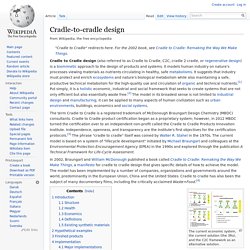
It models human industry on nature's processes viewing materials as nutrients circulating in healthy, safe metabolisms. It suggests that industry must protect and enrich ecosystems and nature's biological metabolism while also maintaining a safe, productive technical metabolism for the high-quality use and circulation of organic and technical nutrients.[1] Put simply, it is a holistic economic, industrial and social framework that seeks to create systems that are not only efficient but also essentially waste free.[2] The model in its broadest sense is not limited to industrial design and manufacturing; it can be applied to many aspects of human civilization such as urban environments, buildings, economics and social systems. Introduction[edit]